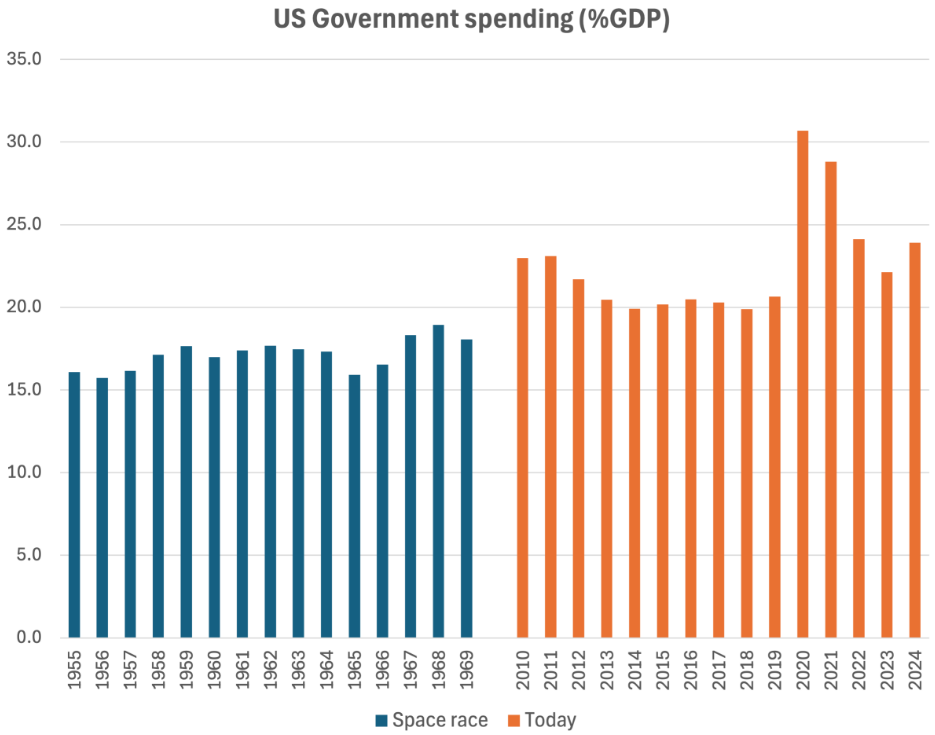A moonshot in the dark: industrial policy’s pros and cons
Industrial policy is all the rage, embraced by both US presidential candidates and favored by parties across the political spectrum in countless countries. Now even the International Monetary Fund, in its latest Finance & Development magazine, gives pride of place to Mariana Mazzucato’s article “Policy with a Purpose: Modern industrial policy should shape markets, not just fix their failures.”
Mazzucato, an economics professor at University College London, has long been a proponent of broader government intervention. Her doctrine could be summed up as “governments do it better,” where “it” includes growth and innovation. Rather predictably, her IMF piece sports an image of the 1969 moon landing: President Kennedy’s moonshot is taken as proof of the government’s awesome ability to generate innovation. There is a key difference between the original “moonshot” and modern industrial policy, however.

“Because they are hard”
“We choose to go to the moon. We choose to go to the moon in this decade and do the other things, not because they are easy, but because they are hard, because that goal will serve to organize and measure the best of our energies and skills, because that challenge is one that we are willing to accept, one we are unwilling to postpone, and one which we intend to win… ”. These are the words used by President John F. Kennedy, in his address at Rice University, September 12, 1962.
The original moonshot was underpinned by a moral imperative — championing freedom against communism (so it is especially ironic to see it used to justify a “socialist” turn in policy). It set one well-defined goal — going to the moon — not because it would benefit individual industries or sectors of the population, nor because it would bring economic value, but because it would unleash “the best of our energies and skills”.
To this purpose, much of the massive public investment effort went into basic scientific research, through NASA and in partnerships with private universities and companies. Investment in basic research together with the excitement generated by the space program pulled lots of talented young minds into science: the share of US bachelor’s degrees in science and engineering peaked at the time of the moon landing.
The US government also invested heavily in fields like computing, communications, material science, electronics, and this investment sparked innovations that percolated through civilian applications. Its impact was huge. But most of this innovation was carried out by a rich ecosystem of private companies that ran with it, especially as private funding became stronger (with the help of significant tax rate cuts in the mid-1960s). The space program spurred a powerful productive synergy of public and private innovation and ignited an enthusiasm for science that bolstered human capital. But to imply that this innovation would never have happened without the government’s intervention goes one step too far.
Innovation
Invoking the moonshot suggests that without the government in the game we are missing out on life-changing discoveries. But innovation is alive and well. Innovation has never been faster. Artificial Intelligence, quantum computing, 3D-printing, digital-industrial technologies, self-driving cars, drones, flying taxis, synthetic biology and gene editing, bioprinting, virtual reality, augmented reality, wearable technology, telesurgery, robotics, Alexa, Siri,… does it feel like innovation has stalled without the government’s guiding hand?
Read also: Americans’ low trust in US institutions: a challenge for any elected official
If you are not convinced yet, here is a quick and easy reality check: if governments truly were better than the private sector at generating innovation and growth, Europe would be light-years ahead of the US. Instead it is falling further and further behind.
It is a classic sleight of hand: cite NASA’s past success at seeding innovation to justify new policies that are mostly aimed at protecting traditional established industries. Kennedy said, “we choose to do these things because they are hard”; modern industrial policy just aims to make life easier for selected industries.
Money
There is another important consideration, one that the IMF should know better than anyone else: the private sector is now much better placed to deploy resources efficiently and at scale than the public sector[1]. Space exploration itself provides the best example: the space race has been re-ignited by the private sector, led by Elon Musk’s Space X, which has proved far more efficient and effective at launching rockets into space than government.
Moreover, most governments are now strapped for cash, having spent liberally on unproductive causes, from untargeted social subsidies to a plethora of ill-conceived projects. If they really want to play a role in fostering innovation and growth, governments should put their house in order first.
Advocates of industrial policy insist that governments should boldly spend and borrow to spur growth and innovation. After all, the space race saw a massive government investment effort — shouldn’t we be willing to spend and borrow as much today? Well, not really.

During the space race (1955-69), the US government’s deficit averaged just two-thirds of 1% of GDP per year; since 2010 it has averaged over 6% of GDP. We’re overspending and borrowing 10 times more, as a share of the economy. And yes, that’s right: we went to the moon on a balanced budget.
Surely that is because of some crazy tax cuts so that now the government cannot spend as much? Well, not really.

Government spending since 2010 has been on average 5.5%of GDP higher than during the space race, matching the difference in deficit levels. Government expenditures today are over 30% higher than during the space race, in real terms.
So do not tell me the problem is that we are not spending and borrowing enough. As I said, governments should put their house in order first.
Have you seen a government lately?
To dodge the issue of fiscal sustainability, advocates of industrial policy invoke an existential threat (climate change) to justify immediate additional spending. Mazzucato’s IMF-hosted piece makes an even broader claim: left to the private sector, economic growth can veer in dangerous directions, harming the planet and workers. “Economic growth is worth striving for only if it’s sustainable and inclusive,” she writes. Hence, government must direct economic growth, to make sure it is sustainable and inclusive.
This line of argument is more dangerous than the problems it aims to solve. Free markets are not perfect, but we do have solutions. Wherever we think workers are being exploited, let us review the relevant laws. If we think carbon emissions need to be eliminated, let’s set carbon pricing accordingly — and accept the economic cost. Because if perfect governments are an illusion, so is the perfect government. Today’s public sectors more closely resemble Peter Sellers’ bumbling Inspector Clouseau — getting things right rarely and by chance.
Share
I have no doubt that an enlightened government, led by politicians with the country’s future at heart and staffed by competent and honest bureaucrats, could help us reach strong, sustainable and equitable growth. But that is not the governments we have. We are asked to believe that the same governments that wasted money with abandon for the past twenty years can now efficiently “direct growth and shape markets” through a complex web of incentives, subsidies, taxes, public-private partnerships, procurement contracts, all replete with a profusion of conditionalities aimed at achieving a multitude of environmental and social objectives — as the article advocates[2]. That is a big leap of faith.
Read also: Is a coherent trade policy likely to emerge after the Presidential election?
Ironically, Mazzucato herself makes the best case against industrial policy. Towards the end she notes, “Industrial policy requires a competent, confident, entrepreneurial, and dynamic public sector.” Well, that’s exactly what we do not have. Confident, maybe, but virtually no country today can boast a competent, entrepreneurial and dynamic public sector (Singapore being a notable exception). The failures of today’s public sector are awe-inspiring: unsustainable debts, the aiding and abetting of a historic financial crisis, bankrupt health and pension systems, the highest inflation in half a century, the catastrophically irrational response to the Covid pandemic, immigration non-policies that are fueling racism and social instability. You want this public sector to “direct growth and shape markets”? Please. Let us fix the public sector first, then we will talk.
FOOTNOTES:
[1] Once, cash-strapped countries facing a balance-of-payments crisis had no alternative but to turn to the IMF. Then private financial markets grew in size and efficiency, and countries willing to put better policies in place can now raise financing on the private market.
[2] The article itself highlights a typical reason why industrial policy can too easily fail: governments trying to reach multiple goals in a classical pork-barrel approach. Mazzucato praises the fact that “In the US, companies can access funding under the Creating Helpful Incentives to Produce Semiconductors (CHIPS) and Science Act, a key prong of the Biden administration’s industrial strategy, only if they commit to climate and workforce development plans. They must also provide accessible childcare, pay certain workers prevailing wages, invest in communities in consultation with local stakeholders, and share a portion of profits above an agreed threshold for funding of $150 million or more. Stock buybacks are excluded from CHIPS funding, and the legislation discourages them for five years.” With so many extraneous considerations thrown in, chances of reaching the main objective — spurring domestic production of advanced microchips — are greatly diminished.
*This article has originally been published here
